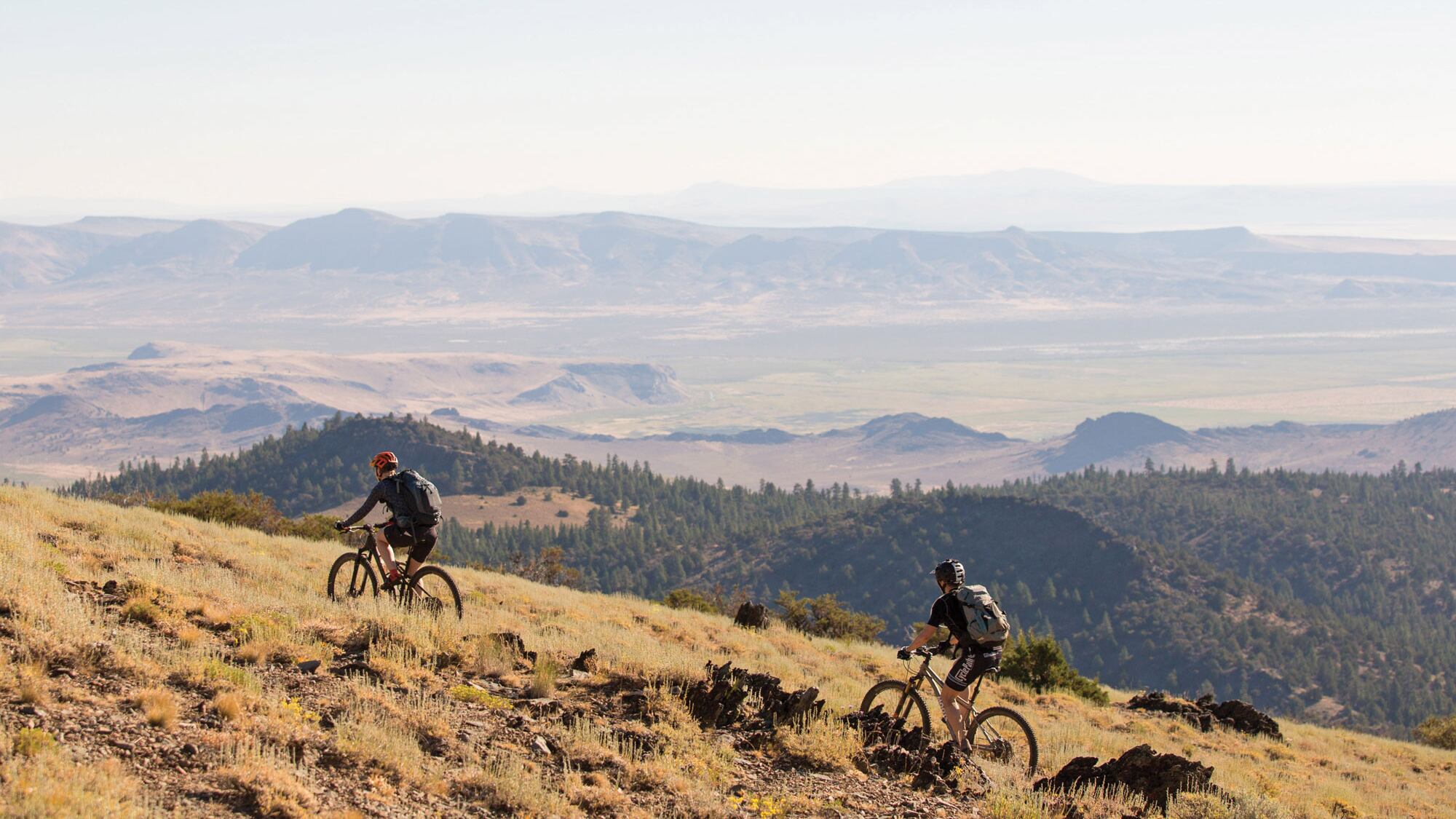When Kim McCormack agreed to pioneer the Oregon Timber Trail, she was given two instructions.
"One, don't die," McCormack says. "Two, don't die."
The Timber Trail is a mountain bike route that spans the state of Oregon from the Washington to California border. Intended as a mountain biker's Pacific Crest Trail, the Timber Trail is a network of mostly single track path through some of Oregon's most remote, spectacular scenery—mountain views near Sisters, rugged desert terrain and old-growth forests lining lakes high in the Cascades.
Two years ago, McCormack and her co-pioneer, Sam Clark, became the first people to complete the 668-mile journey. The trail officially opened last summer. Now, it has an extensive handbook and a team of volunteers dedicated to trail maintenance. But when McCormack and Clark set off from the Washington border in July 2016, the route was still theoretical, and neither knew exactly what they were getting themselves into.
Somehow, McCormack and Clark managed to complete the trip ahead of schedule. Timber Trail's website recommends allotting up to 30 days to ride the entire trail. It took McCormack and Clark only 14. It sounds grueling, but McCormack seems nonplussed.
"I wouldn't call myself an athlete," she says. "Anybody can do it."
Instead of viewing the Timber Trail as something to be conquered, McCormack viewed the expedition with a decidedly zen attitude. "All you have to do is wake up, eat some breakfast, ride your bike, enjoy the day, have some dinner, go to bed and repeat," says McCormack. "That took a lot of intimidation away."
Here's McCormack's guide to remaining calm while spending weeks on a bike in the middle of nowhere.
ESSENTIALS
There isn't any signage along the Timber Trail, and very few segments of the route have cellphone service, so you'll need satellite GPS. Though there are water sources along the way, some dry up in high heat, and the quality of the water varies. Overpack water and bring a backup purification system. Plan your resupply points ahead of time and pack lots of food. Check OTT's website for hazards and closures before riding any part of the trail.
IDEAL VISITING TIME
The OTT is open from mid-June through mid-October, but the closer to the peak of summer, the better. Otherwise, you may encounter snowfall at high elevations.

DON'T OVERDO IT
"On day two or three, I started to wonder what I had gotten myself into," says McCormack. "[The temperature] was triple digits for most of our trip, and the Fremont Tier has a lot of exposure."
So McCormack wore a breathable long-sleeve shirt, packed lots of sunscreen and had daily meet-ups with her husband, Ben, and photographer Leslie Kehmeier, who drove to each checkpoint so they could resupply the two bikers with food and water.
"That would be a big thing if someone was going to ride this, to plan ahead their resupply spots and where they're going to get water, especially for the southern half," McCormack says. "I overdid it. I probably drank about 3 liters a day. It doesn't matter how fit I am—dehydration, not having enough calories or sunburn will take even the strongest person out."
McCormack and Clark also overestimated their arrival date so they didn't have to overexert themselves.
"We just happened to get done sooner because we didn't push ourselves," she says. "As long as you have the proper hydration and nutrition, you can just ride all day long."

EAT A LOT
McCormack estimates she consumed at least 4,000 calories a day. But at the beginning of the trip, she frequently felt low on fuel.
"When I'm exercising a lot or I'm in the element, I'm just not very hungry," she says. "So on day three, I became very purposeful about eating. I would pack really high-calorie bars, and I would force myself an hour into the ride to eat one of those. So every couple of hours, I was putting in a good couple hundred calories."
The daily resupply checkpoints substantially lessened the load each biker had to carry, but McCormack's pack still weighed around 20 pounds.
"We would take an hour-to-an-hour-and-a-half lunch break, then keep eating after that," says McCormack. "I was really grateful for my plantain chips from Trader Joe's."
CHECK IN WITH SOMEBODY
Stopping at checkpoints for lunch also became a safety feature.
"There were a couple times when I thought, 'I am very far from any help right now,'" says McCormack. "We had a lot of navigation devices. Sam had her Garmin, I had Backcountry Navigator, and then we also had a printed map. We carried a DeLorme [a satellite tracking and messaging device]. We also carried a radio, so when we got close to Ben or Leslie, we could start communicating with each other. Even if we were bikepacking it, which I want to go back and do, I would still set up a similar system where we were checking in with somebody [remotely]."

HAVE AN EVACUATION PLAN
Just before she left for the Timber Trail, McCormack was diagnosed with a congenital disease, and her doctor recommended immediate abdominal surgery.
"I put off my surgery to do this trip," she says. "[The doctors] were like, 'OK, fine, but you need to have a plan because if your intestines spin on themselves, then you have to be at a hospital within a couple hours or you could die.' We had planned evacuation routes, which I think is smart to do regardless. I think that's part of why we were able to relax. Because we planned on what to do in case of an emergency, it helped us just be present in the moment."

MAYBE LEARN TO TUNE A CHAIN SAW AT HIGH ELEVATION
Just before they climbed up Winter Ridge on the southeast edge of the Cascades, Clark and McCormack encountered a large swath of trail that was covered by uprooted trees. McCormack's husband brought a chainsaw to cut through the blowdown, but couldn't get the saw to operate at such a high elevation.
"We had to haul our bikes over the blowdown, like serious, entangled blowdown," says McCormack. "We were just singing and passing our bikes to each other. Even though it was mentally challenging and we weren't going anywhere very fast, we knew that that's what we signed up for. And I like hiking too, so no complaints there. I would say that was probably the most 'Oh my gosh' moment. But never once did I think, 'I'm not going to make it.' I never thought I wish I wasn't doing it. I never thought I wanted to be anywhere else."


